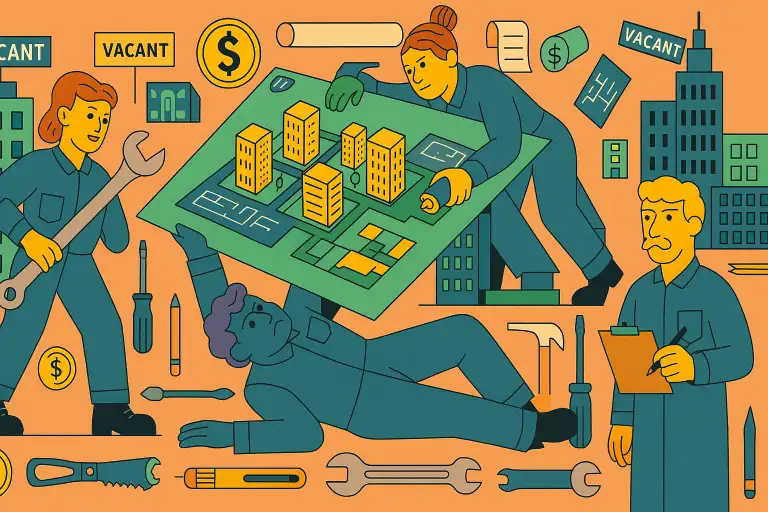Vacant Storefronts, Silent Streets: Inside the Crisis of Korea’s Planned Cities
South Korea’s planned cities were meant to offer modern urban life. Instead, they’re full of vacancy. This is a story about cities without citizens.

“Are we building cities for those who live in them, or for those who sell them?”As long as this question remains unasked, the result will be the same: more empty storefronts, more shopping centers without shoppers, and more residents consigned to isolated spaces—unable to buy, unable to belong, and increasingly estranged from the very cities they call home.
For decades, South Korea has relied on one of the world’s most aggressive and efficient models of urban development. Facing housing shortages, population concentration in the capital, and the need for regional revitalization, the state responded with a formula both elegant and forceful: designate new land, zone it from scratch, build fast, and sell early. From satellite housing districts to fully planned administrative cities, this model has been credited with stabilizing real estate prices, redistributing growth beyond Seoul, and showcasing national capacity for large-scale urban engineering.
But beneath the surface of that success lies an emerging dissonance. Across a growing number of newly built districts, the streets are empty. The storefronts are dark. The infrastructure is complete, yet urban life remains conspicuously absent. Nowhere is this more apparent than in Busan’s western expansion—specifically Myeongji International New Town and the more recent Eco Delta City—and in Sejong, the country’s youngest city and administrative capital. All three were launched with the same ambitions: to relieve pressure on existing urban cores, to foster local economies, and to embody 21st-century urban ideals. Yet all three, despite their spatial polish and policy pedigree, are struggling to function as actual cities.
In Myeongji, residential towers are fully occupied, but commercial corridors sit largely empty, the rhythms of everyday life failing to emerge. Just ten kilometers north, Eco Delta City offers an even more technologically advanced blueprint—with smart mobility grids and eco-infrastructure—but shows the same pattern of vacancy, underuse, and commercial fragility. And further inland, Sejong holds the dubious distinction of having the highest commercial vacancy rate in the nation, with more than one in four retail units unoccupied.
These are not isolated misfires. They are the results of a system that builds physical space faster than social, economic, or demographic realities can fill it. In place of vibrant neighborhoods, what often materializes are frozen districts—planned on paper, delivered in concrete, but never fully inhabited in spirit. South Korea’s planning success may have created cities, but in many cases, it has not created urbanity.
This investigation examines the widening gap between urban ambition and lived experience, focusing on how a state-led, land-centered development model has repeatedly delivered form without function. From parcel-based planning in Busan to symbolic statecraft in Sejong, the promise of balanced growth is running into the limits of a real estate–driven paradigm—one that measures progress by the square meter, rather than by the meter walked, bought, or shared.
What happens when cities are built, but no one arrives—not for shopping, not for working, not even for staying?
Myeongji and Eco Delta City – The Limits of Western Expansion
In the early 2010s, Busan’s city planners set their sights westward. The traditional port city had long been concentrated along its eastern coastline, hemmed in by mountains and stretched by legacy infrastructure. To ease housing pressure, accommodate new industries, and elevate Busan’s international profile, officials launched a series of large-scale projects in the vast, flat lands of Gangseo District. Chief among them was Myeongji International New Town, a flagship development meant to offer not just residential density, but a complete urban environment—waterfront views, international schools, business clusters, and vibrant commercial streets.
The planning documents promised balance: a self-sustaining district where people could live, work, and spend. The reality more than a decade later is far more uneven. Myeongji’s housing component is largely complete. Tens of thousands of residents have moved into its apartment towers, many attracted by affordability, green space, and easy car access. But the neighborhood’s commercial landscape tells a different story. Streets lined with shopfronts remain visibly underused. Office towers stand half-empty. And small businesses struggle to survive without the pedestrian flow or workplace crowd that traditional retail environments depend on.
The result is a district that exists as housing, but not as city. Residents commute elsewhere to shop, socialize, and work. Public transport links remain limited. Third spaces—those informal gathering places that give neighborhoods texture—are scarce. The area functions more like a well-planned dormitory than a living community. As one resident put it, “It’s where I sleep, not where I stay.”
Just ten kilometers north, Eco Delta City was supposed to avoid these very pitfalls. Positioned as South Korea’s most ambitious smart city initiative, the project was designed not just to relieve urban pressure, but to redefine how cities operate. With its eco-friendly water management system, IoT-connected infrastructure, and climate-resilient design, EDS was marketed as a model of the future. But here too, the disconnect between infrastructure and inhabitance is becoming clear. Retail units remain unopened. Community life has yet to materialize. In theory, the city is a test bed for 21st-century urban living; in practice, it is a polished but empty shell.
The common thread between Myeongji and Eco Delta is not poor design per se, but a sequencing failure baked into the structure of public land development. Retail and office space are zoned and built early, often ahead of population growth and behavioral demand. Plots are auctioned off, developers build out their parcels, and shops are sold or leased before there are customers to sustain them. What was intended to be a complete urban environment becomes a commercial landscape divorced from local rhythms.
This mismatch is not incidental—it is systemic. The underlying logic of “develop first, populate later” reflects a model where cities are built to fulfill policy targets and land-sale revenues, rather than to cultivate lived economies. Urbanism becomes something delivered, not grown. And the commercial voids left in this process are not just spatial gaps, but social ones: they represent the absence of habit, of memory, of density not just of people, but of purpose.
In both Myeongji and Eco Delta, the lesson is clear. Without organic demand, commerce cannot be planned into existence. A smart grid cannot make a neighborhood walkable. Green-certified architecture does not guarantee civic life. These districts demonstrate the limits of even the most sophisticated plans when those plans are deployed ahead of people, ahead of activity, and ahead of time.
Sejong – The Ambition of a Capital, The Absence of Urban Life
If Busan’s western expansion reflects a municipal effort to redistribute growth, Sejong represents the most ambitious expression of South Korea’s national-scale urban planning. Conceived in the early 2000s as part of a political strategy to decentralize power from Seoul, Sejong was envisioned as a purpose-built administrative capital: a city that would house ministries, attract research institutes, accommodate civil servants, and eventually mature into a dynamic urban core. Unlike Myeongji or Eco Delta City, which were built around residential and environmental logic, Sejong was built around governance itself.
The city’s design was comprehensive, even utopian in scope. Streets were broad and orderly, housing zones carefully arranged, public spaces ample, and government buildings clustered in a dedicated corridor. High-speed rail and expressways ensured accessibility, while generous subsidies lured public institutions to relocate. The assumption was that economic activity, cultural life, and organic growth would follow the administrative backbone.
More than a decade later, that vision remains largely unrealized. Sejong has the infrastructure of a functioning capital, but not the social metabolism of a living city. Its offices are filled during the day, but its retail corridors remain stubbornly quiet. Cafés open late and close early. Restaurants complain of poor turnover despite dense nearby housing. Many residents commute to nearby cities—especially Daejeon—for shopping, education, or entertainment, effectively treating Sejong as a weekday address, not a social center.
Official data confirm what the streets suggest. As of 2025, Sejong holds the highest commercial vacancy rate in South Korea, with more than 25 percent of its storefronts unoccupied. This is not the product of economic recession, nor the aftermath of a pandemic, but rather the result of a planning philosophy that delivered physical completeness without behavioral grounding. Urban functions were stacked efficiently, but never stitched together socially.
Part of the problem lies in the city’s very logic. By frontloading administrative infrastructure and assuming that demand would materialize in its wake, Sejong inverted the organic order of urban development. Public life was not allowed to evolve—it was scripted, zoned, and parceled in advance. Retail areas were assigned to sectors long before foot traffic existed. Residential towers filled up, but pedestrian culture never emerged. Mobility was engineered to optimize flow, not friction—leaving little space for spontaneity, corner cafés, or street-side life.
What’s striking is not simply that Sejong struggles to feel alive, but that its dysfunction mirrors that of projects like Myeongji and Eco Delta City. Despite their different purposes and scales, all three cities suffer from the same temporal distortion: infrastructure arrives first, life second, and by the time communities begin to form, the commercial environment has already calcified or withered. The results are similar—underutilized public spaces, struggling small businesses, and a creeping sense that something vital is missing.
Sejong was meant to be a model. In some ways, it is—but not for reasons planners intended. It has become a case study in the limits of build-first urbanism, a warning that even the best-funded cities cannot will themselves into vitality. A city’s success is not measured by the speed of its construction or the symmetry of its blocks. It is measured by how deeply it is inhabited, how naturally it integrates into the lives of its people.
And in that sense, Sejong may be the most telling example of all: a capital without capital—without civic energy, street life, or the daily mess that defines true urbanism. It reveals that urban ambition alone cannot sustain a city. For that, something more unpredictable—and more human—is required.
The Problem with the Model – Parcel-Based Planning and Pre-Zoned Retail
The challenges facing Myeongji, Eco Delta City, and Sejong are not merely the result of poor implementation or misjudged design. Rather, they reflect a deeper issue embedded in the way South Korea produces its cities—a development model that is structured around land sales and static zoning, not evolving human needs.
At the core of this model is the concept of parcel-based development. Urban land—often reclaimed or undeveloped—is subdivided into standardized blocks, with each plot designated for a fixed purpose: residential, commercial, public use, or institutional. These parcels are then sold off by government agencies or local development corporations to private builders. Revenue from these land sales often finances the city's infrastructure, making speed and scale of sales a financial imperative.
But this sequencing—build infrastructure, sell land, populate later—creates cities where commercial zones are delivered long before there is a stable, organic demand to support them. Retail units are constructed to meet regulatory requirements, not social momentum. Ground floors fill with empty glass storefronts; office towers are erected without anchor tenants. Shops open into stillness. In many cases, they close before the first wave of residents has even unpacked.
This timeline mismatch is more than a planning oversight—it is a byproduct of a system where urban progress is measured by construction milestones and land sale volume, not the emergence of life. Developers face pressure to build quickly and exit quickly; municipalities face pressure to show results on maps and in budgets. The question of whether communities will thrive is deferred—or ignored entirely.
The rigidity of pre-zoned land use adds another layer of inflexibility. Once commercial parcels are designated and sold, they cannot easily be converted or adapted. If the original retail vision proves unviable—which is often the case in underpopulated new towns—these spaces linger in limbo, their function locked by outdated assumptions. Unlike mixed-use, adaptive models seen in parts of Europe or Japan, South Korean cities have little capacity for real-time evolution. They are master-planned, but not community-formed.
The result is a paradox: commercial oversupply amid consumer absence, retail space without retail logic. Local governments boast of “completion rates,” but citizens experience emptiness. Developers meet their contractual obligations, but neighborhoods remain inert. In effect, cities are built to be sold, not to be inhabited.
This structure also makes vacancy self-reinforcing. Once a district gains a reputation for commercial failure, it becomes harder to attract tenants, investment, or even pedestrians. Rents fall, turnover rises, and even functioning businesses struggle to remain visible in a sea of closed shutters. What begins as a timing issue becomes a reputational trap.
Critically, this model also severs the relationship between planning and accountability. By the time vacancy becomes a problem, the actors who shaped the district—planners, developers, land agencies—have already moved on. The burden falls to the small business owners, the residents, and the civic groups trying to revive a space that was never truly designed to live.
In this way, vacancy is not an unfortunate side effect—it is an outcome structurally baked into the system. South Korea’s planning machine delivers architecture with remarkable precision, but it leaves little room for ambiguity, spontaneity, or trial and error. It optimizes for efficiency, not emergence. And in doing so, it too often forgets the very thing cities are meant to hold: the unpredictability of human life.
Who Are These Cities Built For?
Even if South Korea’s new urban developments had perfectly timed their commercial phases and integrated flexible zoning, they would still be up against a larger, more intractable problem: the demographic landscape has shifted beneath them. The country’s cities—new and old—are being built for populations that are no longer growing, no longer uniformly young, and no longer bound by traditional patterns of mobility or consumption.
This is particularly evident in the country’s aging population, a transformation that is not only national in scale but acutely local in consequence. In the very districts where bright visions of family life and upward mobility once animated promotional brochures, the demographic reality is starker. South Korea now has one of the fastest-aging societies in the world, with birth rates at record lows and senior populations steadily rising. In newly built neighborhoods like Myeongji or Sejong, housing units have filled—but often with older households, empty-nest couples, or civil servants whose work is transient and whose families remain elsewhere.
The result is that many of these cities lack not just density, but dynamism. The age distribution of residents skews against the kinds of spontaneous, consumer-driven activity that urban retail depends on. Cafés struggle not just because there’s no one walking by—but because the people who do live nearby may not be the ones likely to linger. Mixed-age density, long seen as a cornerstone of sustainable urbanism, is notably absent.
Even more challenging is the reality that young adults—the demographic most associated with retail vitality, entrepreneurship, and cultural production—are increasingly unwilling to settle in these areas. In places like Sejong, this cohort is notably underrepresented. They are drawn instead to the few dense urban districts where opportunity, community, and cultural relevance converge—places like Seoul’s Mapo or Seoul Forest, not high-rise islands on the periphery of a zoning map.
At the same time, the population that does engage in retail—the small business owners—skews older. More than 40 percent of the self-employed in South Korea are over the age of 60. Many of them entered retail in the absence of other options, often with limited capital and little digital literacy. They face not only high rents and low foot traffic, but a technological environment designed for younger, more connected actors. In the smart city, they are left behind—physically present, economically marginalized.
The gap between the cities being built and the people available to inhabit them is widening. Family-sized apartments continue to dominate housing supply, despite household sizes shrinking and single-person households becoming the national norm. Amenities are distributed with assumptions of nuclear family life, even as caregiving and aging alone have become widespread conditions. Public spaces are optimized for children and commuters, not seniors or multi-generational life.
Ultimately, this is not just a mismatch between space and user—it is a fundamental question of intention. If these cities are not attracting the young, if they do not support the old, and if they lack the functional diversity to support middle-ground households, then who, exactly, are they for?
In the absence of a clear answer, many of these developments become architectural projections—places where urban planners imagine a social future that no longer exists. And as that imagined population fails to appear, what remains is a structural void: a city with the capacity to hold life, but not the social or demographic conditions to generate it.
Consequences Beyond Vacancy – Fragmentation and Urban Distrust
Vacancy is often measured in square meters and lease rates, but its deeper costs are harder to quantify. What disappears when a city fails to deliver on its promise is not just commerce, but confidence—a sense of shared place, rhythm, and expectation. Across South Korea’s newer developments, from Myeongji to Sejong, a subtle but growing form of urban fragmentation is taking root—not between districts, but between people and the cities they inhabit.
In theory, a newly built city offers clarity and opportunity. It promises better infrastructure, modern housing, and proximity to new institutions. But when the cityscape remains quiet, its streets unpeopled and its storefronts dark, the effect is disorienting. What should be a community feels more like a holding zone. Residents begin to live in proximity, but not in relation. The social glue that typically forms around shared space, mutual convenience, and local identity fails to coalesce.
This absence has visible expressions. Public squares remain underused. Parks are maintained but empty. Retail spaces cycle through businesses too quickly for familiarity to set in. Children grow up in environments with few casual encounters beyond school or apartment lobbies. For many, the daily routines of urban life—grabbing coffee on the way to work, running into neighbors, lingering in a bookstore—are simply unavailable.
The psychological impact is subtle but profound. Residents who moved to these cities with hope or expectation often describe a sense of isolation or dislocation. What begins as disappointment can settle into disillusionment. The city becomes something endured rather than engaged. It works for commuting or sleeping, but not for belonging.
This dynamic is especially pronounced among small business owners. Many enter these districts with optimism, often investing their savings into a storefront or franchise unit, trusting the city’s plans and projected growth figures. But in the absence of foot traffic or anchor institutions, they are left fighting structural conditions they did not create. The result is emotional fatigue, financial loss, and a growing distrust—not just of developers or landlords, but of urban development itself as a trustworthy process.
Over time, this erosion of trust produces a quieter, but more persistent risk: withdrawal from civic life. Residents and entrepreneurs alike stop participating in the city as a shared endeavor. They no longer advocate for improvements, form associations, or build routines that animate place. They assume the failure is inevitable. In some areas, this has led to a kind of spatial fatalism—a learned expectation that vacancy, impermanence, and lifelessness are simply what the modern city is.
This cynicism carries long-term implications. As neighborhoods fail to mature, investor confidence erodes. Developers become wary of building in secondary cities. Youth migration accelerates toward a handful of overconcentrated zones, while peripheral areas age into infrastructural obsolescence before they ever reached full use. Policy loses credibility. And the broader public narrative about city-building shifts—from one of possibility to one of skepticism.
These consequences reach beyond the boundaries of any single development. They raise an uncomfortable but urgent question for a country that continues to urbanize while its population shrinks: Can a city be considered successful if it looks complete, but remains uninhabited in every meaningful way?
Until that question is taken seriously, the cycle is likely to repeat. New land will be zoned. New towers will rise. And residents, again, will arrive to find cities not quite empty, but somehow still unmade.
Rethinking the Purpose of Urban Planning
In the polished renderings and policy briefings that accompany South Korea’s newest urban developments, the city is portrayed as a solved equation: density meets infrastructure, commerce follows zoning, and community emerges from design. But reality has resisted this logic. From Myeongji’s silent streets to Sejong’s unlit shopfronts, what these spaces reveal is not merely a temporary lag, but a deeper misalignment between the ambitions of the state and the behaviors of its citizens.
Vacancy, in this context, is not an anomaly. It is a form of feedback—a mirror held up to a system that prioritizes build-out over build-in, quantity over quality, and speed over sequence. South Korea’s development machine has achieved extraordinary feats: it has housed millions, modernized its landscape, and delivered infrastructure with world-class efficiency. But somewhere along the way, it has lost sight of a simple truth: cities are not measured in square meters, but in shared moments. In vibrancy, friction, and the mundane routines that knit strangers into neighbors.
What this moment demands is not just better zoning or longer timelines, but a philosophical reset. A move away from land-led, parcel-based development and toward life-first urbanism—an approach that treats commercial vitality not as a guarantee, but as a condition to be carefully cultivated. It means building not just for population counts, but for patterns of behavior. It means allowing cities to grow, not just to be delivered.
Such a shift would require uncomfortable changes: slower profit cycles, more adaptive zoning, greater public oversight, and a tolerance for uncertainty in design. But it may be the only viable path forward in a country facing demographic decline, generational change, and deepening social fragmentation. The alternative—continuing to build spaces that function on paper but fail in practice—is not sustainable, economically or culturally.
In the end, the question is not how many cities South Korea can build. It is how many it can make matter. A city is not a product to be sold, but a process to be inhabited. Its success lies not in the number of towers it raises, but in the life that takes root beneath them.
Until planning begins with that truth, the distance between what is built and what is lived will continue to grow. And the streets of the new city—wide, gleaming, and profoundly empty—will continue to ask the same quiet question:
What is all this space for, if not for us?



Comments ()